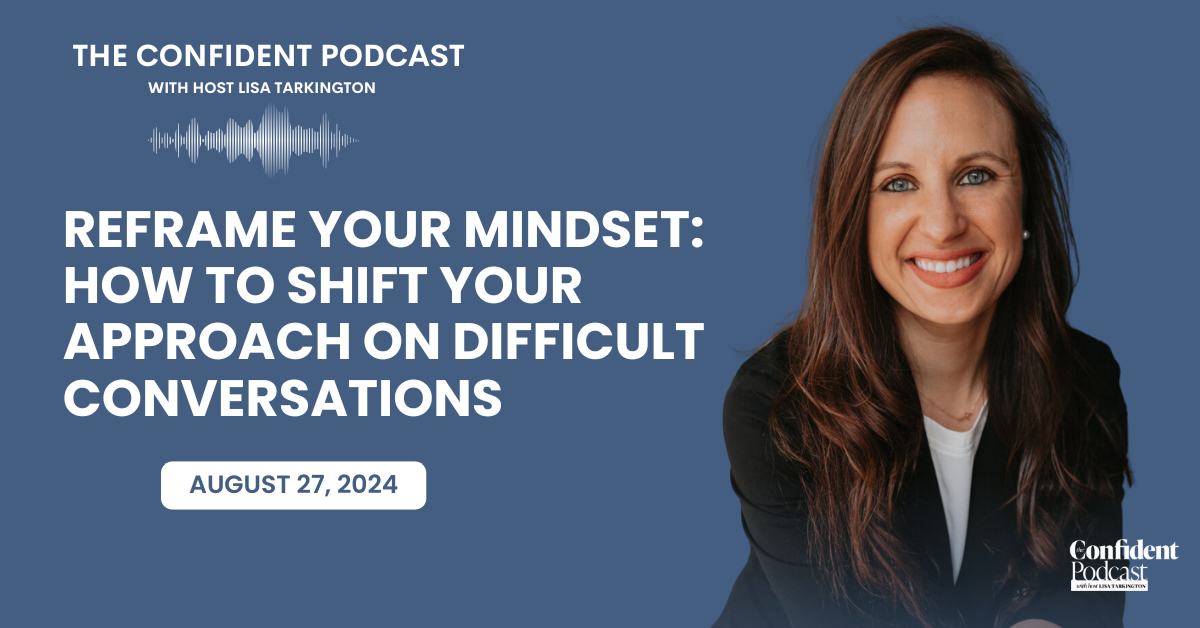Reframe Your Mindset: How to Shift Your Approach On Difficult Conversations
Every conversation is unique, but lately, many people have been coming to me with a common challenge—they struggle with having difficult conversations. Whether it’s addressing a team member, confronting a colleague, or standing up for themselves, they often feel stuck, unsure of how to approach the situation without causing conflict. The “what ifs” play over and over in their minds, stopping them from having these important conversations. And honestly, I get it—I used to be that way too.
There was a time when I would do anything to avoid those tough conversations. I’d give myself excuses, like “it doesn’t matter” or “it will pass,” all in an effort to keep the peace. But in doing so, I was holding myself back. I didn’t realize that by avoiding confrontation, I was missing opportunities to grow, strengthen relationships, and truly lead with confidence. Over time, resentment would build, and I missed out on things I wanted in my life. I’ve talked a bit about this in a past episode on feedback.
But here’s what I’ve learned, and what I see now with the individuals and companies I work with: difficult conversations don’t have to be a source of fear. Let me say that again—difficult conversations don’t have to be a source of fear. When approached with the right mindset and tools, they can become powerful moments of connection and transformation. That’s what I help my clients achieve every day—empowering them to approach these conversations with confidence and grace. As a leader in Professional Development, I’ve seen incredible shifts happen when someone learns to navigate these moments with clarity and respect. It’s not just about addressing the issue at hand; it’s about leading in a way that leaves everyone involved feeling respected and understood.
First off, I want to share how uncomfortable I used to feel when it came to conflict. I would get anxiety before them, overthink everything, and talk myself out of those conversations with every logistical explanation possible. I won’t say I’m perfect now—because I’m only human—but I’ve done so much work in this space to feel more confident and comfortable. Honestly, I’m way better at them than ever.
Let’s talk about why approaching difficult situations head-on is so important—and how to do it effectively. It all starts with mindset. Before you even step into the conversation, your mindset is key. You need to be in a good headspace because when you’re not, you won’t be effective and might say things that aren’t nice or necessary. Just a few weeks ago, I was overwhelmed, and I knew I couldn’t have any hard conversations that afternoon. I had to shift them and refocus my mindset to a positive place.
Not only that, but we have to work on the perspective we bring into the conversation—and the perspective of the other person. I often tell my clients that the way you perceive the conversation can shape its outcome. Sometimes we go into it with just our perspective, but it’s crucial to consider the other person’s as well. Another key aspect of mindset is reframing the situation. Instead of thinking of it as a confrontation, try reframing it as a constructive dialogue or a collaborative problem-solving session. This shift in language changes the energy you bring into the room.
When I first started doing this in my own life, it made a huge difference. I wasn’t walking into a battle; I was walking into an opportunity for growth and understanding. So, take a moment before the conversation to center yourself. Remind yourself of your intentions—whether it’s to resolve an issue, strengthen a relationship, or clear the air—and let go of any anxiety around potential conflict. Then, take a deep breath.
Next, let’s discuss how to approach the conversation. Preparation is essential, but it’s not just about knowing your points; it’s about approaching the dialogue with an open mind. Ask yourself these questions: What is the goal? What is making you need this conversation? What issue will it resolve? What is the outcome you want? Then, do the same for the other person.
One strategy I recommend is starting the conversation by acknowledging common ground or mutual goals. For example, one of my clients had a tough discussion with a team member about missed deadlines. We prepared by focusing on their shared commitment to the project’s success. This approach set a positive tone and made the conversation feel like a joint effort rather than a confrontation.
Begin by expressing your intention to find a solution that works for everyone, and then calmly present your concerns. Remember, it’s not about winning—it’s about reaching a mutual understanding.
Finally, let’s focus on shifting the energy from confrontation to collaboration. The language we use can transform the nature of the conversation. Instead of thinking of it as a confrontation, view it as a collaborative conversation or a constructive discussion. This isn’t just semantics—it’s about changing the narrative in your mind.
Energy is key—your body language, tone, and how you’re in the room with someone all matter for creating ease and grace. You should never approach someone out of nowhere, especially if they’ve had other things happen that morning. Pointing fingers, playing the blame game, and making it their fault will not work.
When you approach a conversation as a collaboration, you’re more likely to listen actively, empathize, and seek solutions that benefit everyone involved. So, if you’re fired up, don’t go into this like that. Have the self-awareness to take a minute first. I’ve seen this mindset shift work wonders for my clients. They go from dreading these talks to embracing them as opportunities for connection and growth.
And the more you do it, the easier it is to look at it this way. I also always recommend practicing and writing down your thoughts. It won’t go perfectly, but it will help you get things out of your mind. I often do this so I don’t say the wrong thing in the conversation. I promise you, this is a start. You need to knock down your own walls and the other person’s too to find middle ground.
To recap, here are three things you can start doing today to approach difficult conversations with confidence and grace:
1. Mindset Shift: Reframe the conversation from a confrontation to a collaborative discussion.
2. Approach: Prepare by focusing on common goals and approach the dialogue with openness and calm.
3. Language and Energy: Use language that promotes collaboration and reduces tension.
By applying these strategies, you’ll be better equipped to handle difficult conversations with confidence and grace. Remember, it’s not about avoiding conflict; it’s about leading through it in a way that fosters growth and mutual respect.
Lead Within, the newly launched online membership platform, is designed to empower individuals in personal and professional growth. With a wealth of content and interactive resources, it provides continuous support for those navigating their confidence journey. This month, we launched our new topic: Self-awareness. Join today and practice all of the tips we talked about in this week’s episode!
If you’re ready to unlock your potential, visit Lead Within and use promo code podcast50 for 50% off your first month.
Subscribe & watch the full episode on YouTube!
Stay Connected with The Confident Podcast!
Want more confidence content, tips, and resources? Connect with The Confident Podcast on our social platforms!
- Listen to the podcast on: Apple Podcast, Spotify, YouTube and Other podcast channels
- Follow The Confident Podcast on Instagram & Tik Tok
- Connect & Follow our host, Lisa Tarkington: Instagram & Linkedin
- Thank you to our Sponsor Athletic Greens! Click here to order a free gift!




